Geon Lee
SDS KoPub VDR: A Benchmark Dataset for Visual Document Retrieval in Korean Public Documents
Nov 07, 2025Abstract:Existing benchmarks for visual document retrieval (VDR) largely overlook non-English languages and the structural complexity of official publications. To address this critical gap, we introduce SDS KoPub VDR, the first large-scale, publicly available benchmark for retrieving and understanding Korean public documents. The benchmark is built upon a corpus of 361 real-world documents (40,781 pages), including 256 files under the KOGL Type 1 license and 105 from official legal portals, capturing complex visual elements like tables, charts, and multi-column layouts. To establish a challenging and reliable evaluation set, we constructed 600 query-page-answer triples. These were initially generated using multimodal models (e.g., GPT-4o) and subsequently underwent a rigorous human verification and refinement process to ensure factual accuracy and contextual relevance. The queries span six major public domains and are systematically categorized by the reasoning modality required: text-based, visual-based (e.g., chart interpretation), and cross-modal. We evaluate SDS KoPub VDR on two complementary tasks that reflect distinct retrieval paradigms: (1) text-only retrieval, which measures a model's ability to locate relevant document pages based solely on textual signals, and (2) multimodal retrieval, which assesses retrieval performance when visual features (e.g., tables, charts, and layouts) are jointly leveraged alongside text. This dual-task evaluation reveals substantial performance gaps, particularly in multimodal scenarios requiring cross-modal reasoning, even for state-of-the-art models. As a foundational resource, SDS KoPub VDR not only enables rigorous and fine-grained evaluation across textual and multimodal retrieval tasks but also provides a clear roadmap for advancing multimodal AI in complex, real-world document intelligence.
A Self-Supervised Mixture-of-Experts Framework for Multi-behavior Recommendation
Aug 28, 2025Abstract:In e-commerce, where users face a vast array of possible item choices, recommender systems are vital for helping them discover suitable items they might otherwise overlook. While many recommender systems primarily rely on a user's purchase history, recent multi-behavior recommender systems incorporate various auxiliary user behaviors, such as item clicks and cart additions, to enhance recommendations. Despite their overall performance gains, their effectiveness varies considerably between visited items (i.e., those a user has interacted with through auxiliary behaviors) and unvisited items (i.e., those with which the user has had no such interactions). Specifically, our analysis reveals that (1) existing multi-behavior recommender systems exhibit a significant gap in recommendation quality between the two item types (visited and unvisited items) and (2) achieving strong performance on both types with a single model architecture remains challenging. To tackle these issues, we propose a novel multi-behavior recommender system, MEMBER. It employs a mixture-of-experts framework, with experts designed to recommend the two item types, respectively. Each expert is trained using a self-supervised method specialized for its design goal. In our comprehensive experiments, we show the effectiveness of MEMBER across both item types, achieving up to 65.46% performance gain over the best competitor in terms of Hit Ratio@20.
KGMEL: Knowledge Graph-Enhanced Multimodal Entity Linking
Apr 21, 2025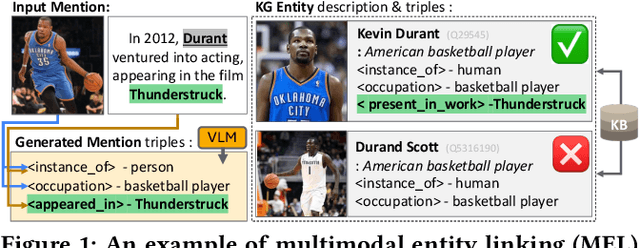



Abstract:Entity linking (EL) aligns textual mentions with their corresponding entities in a knowledge base, facilitating various applications such as semantic search and question answering. Recent advances in multimodal entity linking (MEL) have shown that combining text and images can reduce ambiguity and improve alignment accuracy. However, most existing MEL methods overlook the rich structural information available in the form of knowledge-graph (KG) triples. In this paper, we propose KGMEL, a novel framework that leverages KG triples to enhance MEL. Specifically, it operates in three stages: (1) Generation: Produces high-quality triples for each mention by employing vision-language models based on its text and images. (2) Retrieval: Learns joint mention-entity representations, via contrastive learning, that integrate text, images, and (generated or KG) triples to retrieve candidate entities for each mention. (3) Reranking: Refines the KG triples of the candidate entities and employs large language models to identify the best-matching entity for the mention. Extensive experiments on benchmark datasets demonstrate that KGMEL outperforms existing methods. Our code and datasets are available at: https://github.com/juyeonnn/KGMEL.
MARIOH: Multiplicity-Aware Hypergraph Reconstruction
Apr 01, 2025Abstract:Hypergraphs offer a powerful framework for modeling higher-order interactions that traditional pairwise graphs cannot fully capture. However, practical constraints often lead to their simplification into projected graphs, resulting in substantial information loss and ambiguity in representing higher-order relationships. In this work, we propose MARIOH, a supervised approach for reconstructing the original hypergraph from its projected graph by leveraging edge multiplicity. To overcome the difficulties posed by the large search space, MARIOH integrates several key ideas: (a) identifying provable size-2 hyperedges, which reduces the candidate search space, (b) predicting the likelihood of candidates being hyperedges by utilizing both structural and multiplicity-related features, and (c) not only targeting promising hyperedge candidates but also examining less confident ones to explore alternative possibilities. Together, these ideas enable MARIOH to efficiently and effectively explore the search space. In our experiments using 10 real-world datasets, MARIOH achieves up to 74.51% higher reconstruction accuracy compared to state-of-the-art methods.
Multi-Behavior Recommender Systems: A Survey
Mar 10, 2025Abstract:Traditional recommender systems primarily rely on a single type of user-item interaction, such as item purchases or ratings, to predict user preferences. However, in real-world scenarios, users engage in a variety of behaviors, such as clicking on items or adding them to carts, offering richer insights into their interests. Multi-behavior recommender systems leverage these diverse interactions to enhance recommendation quality, and research on this topic has grown rapidly in recent years. This survey provides a timely review of multi-behavior recommender systems, focusing on three key steps: (1) Data Modeling: representing multi-behaviors at the input level, (2) Encoding: transforming these inputs into vector representations (i.e., embeddings), and (3) Training: optimizing machine-learning models. We systematically categorize existing multi-behavior recommender systems based on the commonalities and differences in their approaches across the above steps. Additionally, we discuss promising future directions for advancing multi-behavior recommender systems.
Explainable Multi-modal Time Series Prediction with LLM-in-the-Loop
Mar 02, 2025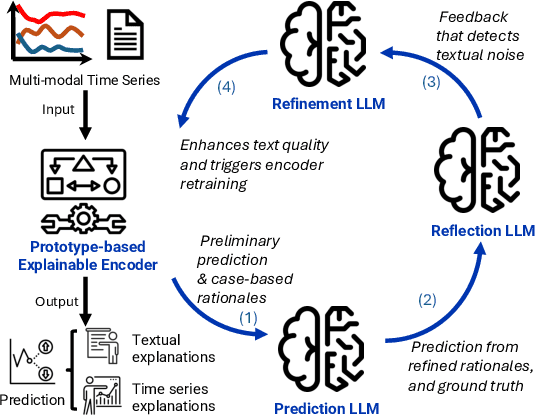

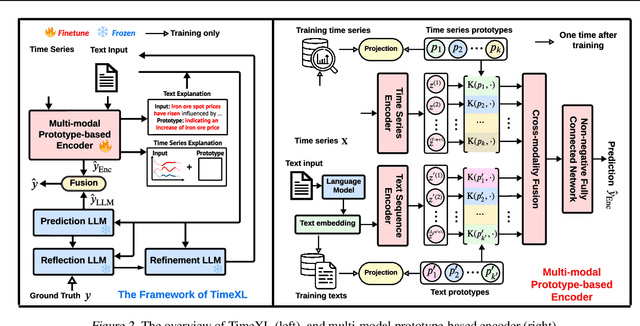
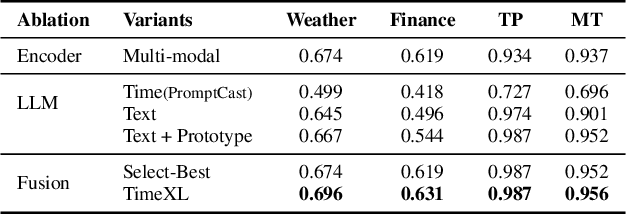
Abstract:Time series analysis provides essential insights for real-world system dynamics and informs downstream decision-making, yet most existing methods often overlook the rich contextual signals present in auxiliary modalities. To bridge this gap, we introduce TimeXL, a multi-modal prediction framework that integrates a prototype-based time series encoder with three collaborating Large Language Models (LLMs) to deliver more accurate predictions and interpretable explanations. First, a multi-modal prototype-based encoder processes both time series and textual inputs to generate preliminary forecasts alongside case-based rationales. These outputs then feed into a prediction LLM, which refines the forecasts by reasoning over the encoder's predictions and explanations. Next, a reflection LLM compares the predicted values against the ground truth, identifying textual inconsistencies or noise. Guided by this feedback, a refinement LLM iteratively enhances text quality and triggers encoder retraining. This closed-loop workflow -- prediction, critique (reflect), and refinement -- continuously boosts the framework's performance and interpretability. Empirical evaluations on four real-world datasets demonstrate that TimeXL achieves up to 8.9\% improvement in AUC and produces human-centric, multi-modal explanations, highlighting the power of LLM-driven reasoning for time series prediction.
TimeCAP: Learning to Contextualize, Augment, and Predict Time Series Events with Large Language Model Agents
Feb 17, 2025Abstract:Time series data is essential in various applications, including climate modeling, healthcare monitoring, and financial analytics. Understanding the contextual information associated with real-world time series data is often essential for accurate and reliable event predictions. In this paper, we introduce TimeCAP, a time-series processing framework that creatively employs Large Language Models (LLMs) as contextualizers of time series data, extending their typical usage as predictors. TimeCAP incorporates two independent LLM agents: one generates a textual summary capturing the context of the time series, while the other uses this enriched summary to make more informed predictions. In addition, TimeCAP employs a multi-modal encoder that synergizes with the LLM agents, enhancing predictive performance through mutual augmentation of inputs with in-context examples. Experimental results on real-world datasets demonstrate that TimeCAP outperforms state-of-the-art methods for time series event prediction, including those utilizing LLMs as predictors, achieving an average improvement of 28.75% in F1 score.
Cerberus: Attribute-based person re-identification using semantic IDs
Dec 02, 2024Abstract:We introduce a new framework, dubbed Cerberus, for attribute-based person re-identification (reID). Our approach leverages person attribute labels to learn local and global person representations that encode specific traits, such as gender and clothing style. To achieve this, we define semantic IDs (SIDs) by combining attribute labels, and use a semantic guidance loss to align the person representations with the prototypical features of corresponding SIDs, encouraging the representations to encode the relevant semantics. Simultaneously, we enforce the representations of the same person to be embedded closely, enabling recognizing subtle differences in appearance to discriminate persons sharing the same attribute labels. To increase the generalization ability on unseen data, we also propose a regularization method that takes advantage of the relationships between SID prototypes. Our framework performs individual comparisons of local and global person representations between query and gallery images for attribute-based reID. By exploiting the SID prototypes aligned with the corresponding representations, it can also perform person attribute recognition (PAR) and attribute-based person search (APS) without bells and whistles. Experimental results on standard benchmarks on attribute-based person reID, Market-1501 and DukeMTMC, demonstrate the superiority of our model compared to the state of the art.
IRASNet: Improved Feature-Level Clutter Reduction for Domain Generalized SAR-ATR
Sep 25, 2024



Abstract:Recently, computer-aided design models and electromagnetic simulations have been used to augment synthetic aperture radar (SAR) data for deep learning. However, an automatic target recognition (ATR) model struggles with domain shift when using synthetic data because the model learns specific clutter patterns present in such data, which disturbs performance when applied to measured data with different clutter distributions. This study proposes a framework particularly designed for domain-generalized SAR-ATR called IRASNet, enabling effective feature-level clutter reduction and domain-invariant feature learning. First, we propose a clutter reduction module (CRM) that maximizes the signal-to-clutter ratio on feature maps. The module reduces the impact of clutter at the feature level while preserving target and shadow information, thereby improving ATR performance. Second, we integrate adversarial learning with CRM to extract clutter-reduced domain-invariant features. The integration bridges the gap between synthetic and measured datasets without requiring measured data during training. Third, we improve feature extraction from target and shadow regions by implementing a positional supervision task using mask ground truth encoding. The improvement enhances the ability of the model to discriminate between classes. Our proposed IRASNet presents new state-of-the-art public SAR datasets utilizing target and shadow information to achieve superior performance across various test conditions. IRASNet not only enhances generalization performance but also significantly improves feature-level clutter reduction, making it a valuable advancement in the field of radar image pattern recognition.
Disentangled Representations for Short-Term and Long-Term Person Re-Identification
Sep 09, 2024
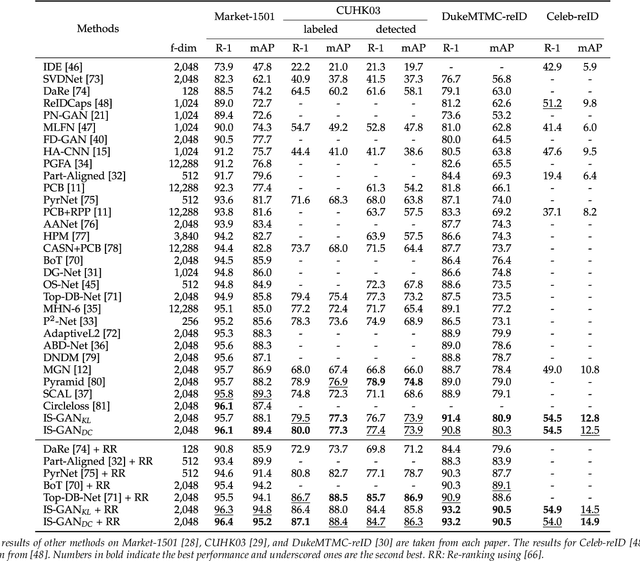

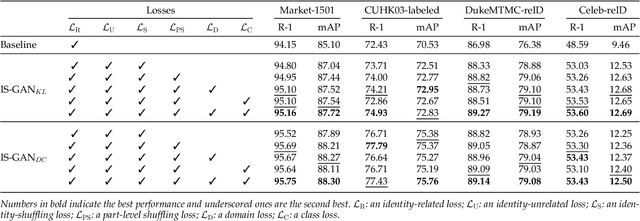
Abstract:We address the problem of person re-identification (reID), that is, retrieving person images from a large dataset, given a query image of the person of interest. A key challenge is to learn person representations robust to intra-class variations, as different persons could have the same attribute, and persons' appearances look different, e.g., with viewpoint changes. Recent reID methods focus on learning person features discriminative only for a particular factor of variations (e.g., human pose), which also requires corresponding supervisory signals (e.g., pose annotations). To tackle this problem, we propose to factorize person images into identity-related and unrelated features. Identity-related features contain information useful for specifying a particular person (e.g., clothing), while identity-unrelated ones hold other factors (e.g., human pose). To this end, we propose a new generative adversarial network, dubbed identity shuffle GAN (IS-GAN). It disentangles identity-related and unrelated features from person images through an identity-shuffling technique that exploits identification labels alone without any auxiliary supervisory signals. We restrict the distribution of identity-unrelated features or encourage the identity-related and unrelated features to be uncorrelated, facilitating the disentanglement process. Experimental results validate the effectiveness of IS-GAN, showing state-of-the-art performance on standard reID benchmarks, including Market-1501, CUHK03, and DukeMTMC-reID. We further demonstrate the advantages of disentangling person representations on a long-term reID task, setting a new state of the art on a Celeb-reID dataset.
* arXiv admin note: substantial text overlap with arXiv:1910.12003
 Add to Chrome
Add to Chrome Add to Firefox
Add to Firefox Add to Edge
Add to Edge